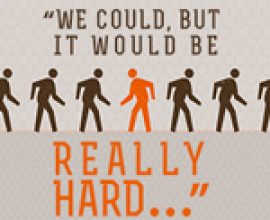Times have changed, especially in the church world over the last decade. Not too long ago you had a church secretary that would click the magical “clip art” button and insert some little “graphic” piece, usually pretty tacky, onto the weekly bulletin template. That was pretty much the extent of graphic art in church. Now, there are many churches leading the way worldwide in the field of graphic and video production. There are a lot of churches that are trying to break into this area by hiring a team of artists to be on staff, putting together a group of volunteers or even hiring out to freelance artists.
As I’ve worked with or consulted with many churches, I’ve seen a real struggle in trying to communicate with or guide these artists. Most of the time this isn’t a poor reflection on the artists being used but instead is a result of a lack of communication or knowledge of how the process should work from those in leadership that are overseeing the project. In this post I’d like to outline what I believe to be the best way to direct your graphic artists.
There are two different approaches that I use depending on whether I’m using an artist that is on my staff or if it’s an artist that I’m hiring freelance.
We’ll look first at an artist that is on my staff:
I like to let artists that are on my staff be creative. These people are usually some of the most creative people that you will ever meet, use it, but don’t abuse it.
1. Clearly communicate the vision
This is where I let them know the exact purpose of this piece of graphic art or video. I communicate the feel as well as ALL information that is to be communicated. Set preliminary timelines for next steps and for the entire project.
2. Listen to their ideas
Once I’ve communicated everything that they need to know, I give them time to marinate on it. We’ll gather back up sometimes hours or days later for them to ask any questions they may have and for them to pitch me on whatever ideas they have.
3. Give more direction
After hearing whatever they pitch I narrow it down, decide what idea we’re going to go with and then give more direction on exactly how I envision their final product of this idea to look. If this is a video project, this is where we would storyboard the project. Set timelines for first draft, decide how long you think revisions should realistically take and re-communicate the due date of the final product.
4. Go over first draft with a fine toothcomb
I put the first draft through my visual and mental shredder and see what stands out that need to be addressed. This is also where I make a final decision on if this is the direction that we’re going to continue to go. Sometimes an idea that seems great on the drawing board doesn’t turn out great. As a leader you should be able to tell from the first draft if this idea is really what you want. If it is, then get the details and execution right.
5. Revise until it’s perfect
Revision time can be uncomfortable for both the project manager as well as the artist. Most people want to be liked and have their work liked. Leaders don’t want to upset their team and artists don’t like to be critiqued. Both sides have to get past this. As a project manager it’s your job to make sure that the final product represents everything that it needs to represent. As an artist it’s your job to continue to tweak and revise until the final product represents everything that your project manager wants it to represent.
6. Celebrate the win
Once a project is complete celebrate the team that helped develop it as well as the specific artist that made it happen. Artists can be sensitive and temperamental so do your best to give as much positive feedback as possible to help balance out the possibly perceived negative feedback from the revision process of the project.
As you can see, if I’m working with a team of my staff creative people I give them a lot of input into the project and process. When hiring out a project to a freelance artist I handle things quite differently.
When working with a freelance artist:
1. Know exactly what you want before communicating with the artist
When working with a freelance artist you are paying them for every minute of their time. Therefore, time really is money. I don’t like to waste either of those. You have to know exactly what you want. If it’s a graphic, you can already see the finished product in your head, the feel, the colors, the copy, everything. If it’s a video, you know if it’s a motion video, a live video, you know what type of music will be paired with it, what the storyline and script will be, everything. If you don’t have all of this thoroughly thought through, then don’t contact your artist.
2. Communicate clearly with your artist: USE EXAMPLES
Everything that is in your head now has to be communicated to the artist. The best way to do this is for you to do research ahead of time and have examples of other projects that have the feel or look of what you’re going for. This is the most important step of this process. If you don’t communicate clearly and properly in this stage, you may end up wasting a lot of time and a lot of money. Miscommunication in this stage may also push you past your deadline. NOTE: don’t just communicate by phone and think you’re “ok”. Communicate everything that you want by email and include links to all examples. Most good freelance artists are going to be working with multiple clients and on multiple projects at one time. If they don’t have everything you want in writing, they’ll forget and you’ll both be unhappy.
Make sure you discuss all timelines for the project. Set a date for first draft, a realistic timeline for revisions and a final product due date.
3. Make the revision process short
Again, time is money. For every revision you make back and forth you will take up more time and spend more money. When working with freelance artists, my goal is to only use 2 revisions. When I get the first draft I tear through it as much as possible and communicate every revision that needs to be made. On most projects I expect that after that first revision it should be complete. If it takes more than one or two revisions then I need to honestly evaluate if it is because of me and my poor communication of vision or if it is the talent level of the artist. If it is the latter then I probably won’t hire that artist again.
4. Pay the Artist
A freelance artist has made your project a priority and has given time to completing it. Once they have completed the project and billed you, please pay them and pay them as promptly as possible. You would hate if you didn’t know when your paycheck was going to come in, right? So do they. Make taking care of them a priority. NOTE: Never try to renegotiate their rates.
I know there’s not a ton of information on any of these bullet points. Each point on here could take up an entire post, but I hope that outlining these steps in this manner will help you to think through your project and communicate better with your artist. Let’s just all agree to never use clip art, cool?




